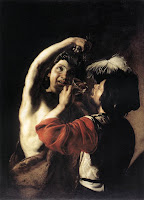Fashion Fall 2007 Winter 2008
 In contrast to the shorter days, lengthening hemlines and cooling temperatures, the world of jewelry heats up this fall casting welcome shades of warm jewel-tones into the dimming corners of 2007.
In contrast to the shorter days, lengthening hemlines and cooling temperatures, the world of jewelry heats up this fall casting welcome shades of warm jewel-tones into the dimming corners of 2007.
This season’s clothing and accessory fashions see the continuance in juxtaposition between materials and styles present in this spring and summers trends. Among these fashionable contradictions are: the ‘Gender-Bender’ versus the ‘Movie Diva’, the tapered ‘Pencil’ waistline versus oversized ‘Baggy’ knitwear, soft ‘Quilted’ textures versus ‘Crystal’ embellishments and ‘Raven Black and Flannel Gray’ versus ‘Purple Wine and Chili Pepper Red.’ The Gender Bender
The Gender Bender
Inspired by equal opportunity and the unisex ethos, this style is epitomized by the classic suit: wide slacks and double-breasted jackets. Military wear and uniforms are key influences this season, so a classic military trench length coat would be an ideal over-garment.
A great conformist outfit for the office, the ‘Gender Bender’ rebels with the addition of feminine accessories: Bold cuff bracelets in sterling silver, plain silver and gold plated chains, charms and silver bangles add a touch of high-octane sheen to the somber but smart monochromes of raven black, flannel gray and off-white of the ‘Gender Bender’ suit.
The Movie Diva
The ‘Diva’ is fashion's tribute to the show-stopping female form exhibiting an elegance echoing Hollywood's golden age. Purple, ruby red or sapphire blue floor-length gowns with plunging décolletages, elbow-length gloves, Mary Jane platform pumps, bold red lipstick and Veronica Lake waves are the essential elements.
Accessories to match such extravagant evening and event-wear this season come in the form of chiffon and velvet wraps, feather boas, grab bags encrusted with multicolored crystals and sequins. Oversized baubles are the perfect ladylike extravagance: huge silver cocktail rings and earrings burning with scintillating Swarovski crystal, Amethyst, Garnets, CZ, Topaz and Citrine.
Pencil Lines & Waistlines
This style is inspired by 30’s and 40’s fashions where the ideal was full-figured, curvaceous and well…female! The essential elements for this look are pencil line or easy-to-wear slim-fit skirts with pleats and hemlines finishing just below the knee tapered at the waist with a slim belt, strong shoulders and a ladylike blouse with more pleats on the sleeves and mid to high-heeled shoes.
On those colder days the whole look can be finished off with a thigh-skimming cocoon, cape style or a shorter length overcoat tied at the waist with a broad belt: a high profile accessory for fall and winter. This minimalist look accommodates discreet jewelry such as silver charm bracelets and gold plated heart pendants, just as much as bolder statement-jewelry like jeweled metal bangles with pretty delicate designs and oversized silver jewelry in CZ, Murano glass or Swarovski crystal.
Oversized Baggy Knitwear
In contrast to the defined pencil silhouette one of the keynote looks this fall is the oversized jumper dress in giant stitching. Thick and chunky cardigans with knitted ruffles are the alternative to coats. These can be completed with outsized scarves and ski jumpers in extravagant knits paving the way forward from fall to winter.
Covering up is critical business this winter and fall season, equestrian-style quilted coats, and padded jackets are seeing a comeback. As the limelight falls firmly on the waist, thick belts are this seasons defining accessory. This particular look is all about textures, offset these soft materials with glittering metallics: palladium, platinum, white gold or sterling silver jewelry depending on your budget.
Colors
Alongside the traditional muted rustic fall colors of brown carafe, burnt ochre, green moss, stargazer and shale green, comes a bevy of warm jewel tones in cashmere rose pink, chili pepper red and yellow lemon-curry. However the dominating color this season is purple wine, a regal shade that will sway fashion heavily this fall. Choose solid masses of complementary color; employ the same shades in a number of layers, and complement with similar colors and tones in your accessories.
Black is back this fall and winter with matt jet-black tones overlaid on satin raven-blacks sparkling with crystals, creating a contrast of textures and tones. Grays ranging from flannel to metallic are essentials as are snow queen whites and creams.
Accessories & Tips
Shine on! Elegance and opulence are keystones in autumn and winter 2007. Finish your desired looks with additional accessories fashioned from exotic feathers, paillettes, outsized crystals, and dresses drenched in sequins.
Matt & Metallic: The metallic look in silver and bronze are big again this autumn, wear separates in different finishes for contrast: matt skirts with shiny blouses, shiny trousers and jackets with fine knits.
Big & Bold: Oversize crystal accessories in silver bracelets and bangles. Amethyst rings and earrings, pink topaz pendants, sparkling red cubic zirconia, ostentatious Murano glass…Go for heavy rather than delicate decoration!
Purple Reigns: From lazy lavender, hazy heliotropes to profound violet: Purple is the princess of all she surveys!
White Metal Cuff Bracelets & Bangles: The dominant jewelry style this autumn and winter is the application of big gems, crystals and enamel into bold palladium, rhodium plated, and silver statement jewelry. A necessity!
Baubles! Cocktail rings are the second must-haves for the party season. At silvershake.com you’ll find them with options of a variety of over fifty gem types from Amethyst to Zircon to match your outfit, adding the quintessence of ladylike femininity.



 Monochrome
Monochrome Tribal,
Tribal,























 Lapis Lazuli
Lapis Lazuli










